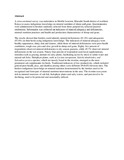Herders' knowledge on mineral nutrition and implication on sheep and goat productivity in Marsabit South District, Kenya

View/
Date
2012Author
Lengarite, M I
Mbugua, P N
Gachuiri, C K
Kabuage, L W
Language
enMetadata
Show full item recordAbstract
A cross-sectional survey was undertaken in Merille location, Marsabit South district of northern Kenya to assess indigenous knowledge on mineral nutrition of sheep and goats. Questionnaires were administered to herders randomly selected from three purposively selected pastoral settlements. Information was collected on indicators of mineral adequacy and deficiencies, mineral nutrition practices and health and production characteristics of sheep and goats.
The results showed that herders could identify mineral deficiencies (81.3%) and adequacies (87.0%) in their herds using indigenous knowledge. The indicators of mineral adequacy were healthy appearance, shiny skin and fatness, while those of mineral deficiencies were poor health conditions, rough coat, pica and slow growth in sheep and goats. Eighty five percent of respondents observed mineral deficiencies to dry season pastures, while 45.7% observed mineral deficiencies in the wet season. Ninety four percent of respondent used local supplementary remedies such as grazing animals on salty plants, facilitating access by stock to saline water and natural salt licks. Halophyte plants, such as Lycium europaeum, Salsola dendriodes, and Salvadora persica species, which are mostly found in the riverine, emerged as the most prominent salt supplements for herds. Traditional indicators of low productivity, which included general poor health, pica, and diarrhea among others were different (P<0.05) between sites. The herders indigenous knowledge on mineral nutrition demonstrated by the herders need to be recognized and form part of mineral nutrition interventions in the area. The riverine ecosystem rich in mineral resources of salt lick, halophyte plants and salty waters, and perceived to be declining, need to be protected and sustainably utilized.
Publisher
University of Nairobi
Collections
- Faculty of Agriculture [226]
